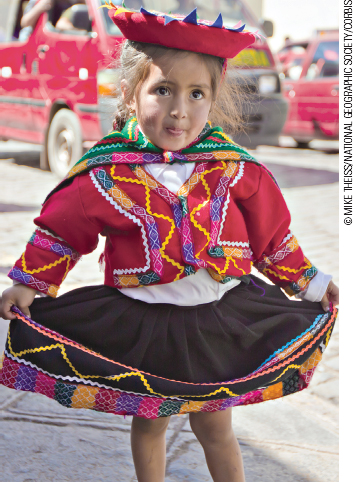Content Changes in the Tenth Edition
Child and adolescent development, like all sciences, builds on past learning. Many facts and concepts are scaffolds that remain strong over time: stages and ages, norms and variations, dangers and diversities, classic theories and fascinating applications. However, the study of development is continually changed by discoveries and experiences, so no paragraph in this tenth edition is exactly what it was in the first edition, and only a few are exactly like the ninth.

Highlights of updates in the text appear below.
Part I. The Beginnings
1. Introduction
New chapter opener on Professor Berger’s experience at the birth of her grandson, Caleb, illustrates some of the reasons for the study of human development
Discussion of the three domains of development brought forward in the chapter
Differential susceptibility illustrated with example of children with a particular version of the serotonin transporter gene 5-
HTTPLR Rationale for the shift by developmentalists from studying only the period of birth through adolescence to studying the entire life span explained in full
The difference-
equals- deficit error defined and discussed Expanded section on sexual orientation
New Opposing Perspectives box considers use of the word race
Plasticity now discussed in the context of the dynamic-
systems approach New A View from Science box discusses the fear of a vaccination–
autism link Visualizing Development: Diverse Complexities
2. Theories
New chapter opener illustrates three aspects shared by all theories: (1) behavior can be surprising, (2) humans develop theories to explain everything, and (3) experience and culture matter
A separate major section now devoted to discussion of each theory
Classical conditioning illustrated by example of white coat syndrome
Discussion of information processing expanded with inclusion of new insights from neuroscience, including photos comparing brain scans of healthy adults with those of adults who were diagnosed with ADHD as children
Physical therapists’ tailoring of treatment regimes to each patient used as an example of guiding someone through the zone of proximal development
The introduction to the universal perspective (humanism and evolutionary theory) has been expanded
In discussion of humanism: long-
term effects on children whose parents did not have unconditional positive regard for them In discussion of evolutionary theory: a new subsection on evolution and culture
Visualizing Development: Breast-
feeding Diversity
3. The New Genetics
Major sections reorganized for smoother information flow
Expanded explanation of genes includes discussion of epigenetics
In discussion of genetic variations: a new paragraph on jumping discusses transfer of some genetic material from one chromosome to the other when sperm and ova pair up
New section on male/female differences in infertility
Expanded section on IVF
Visualizing Development: One Baby or More
4. Prenatal Development and Birth

New chapter opener about the birth of Professor Berger’s grandson illustrates constancies in prenatal development and birth as well changes in culture and context over time
- Page xix
Section on the final three months of pregnancy reorganized to include subsections on organ maturation and the mother–
child relationship Expanded section on cesarean delivery, including a paragraph on negative factors that appear months to years after birth
Behavioral teratogens now discussed in a separate subsection
New A View from Science box discusses conflicting advice given to pregnant women about their health and potential teratogens
New subsection What Do We Know? raises questions about the state of our knowledge of teratogens and their effects
Discussion of low birthweight now a separate major section
New subsection on family bonding
Visualizing Development: A Healthy Newborn
Part II. The First Two Years
5. The First Two Years: Biosocial Development
Failure to thrive now discussed early in the chapter in explanation of percentile rankings
New comparison of infants’ sleep patterns in various cultures
New figure (5.3) indicates percentage of co-
sleeping infants in 14 countries New subsection on specialization of brain areas
In section on brain development: a significantly expanded subsection on transient exuberance of dendrites and pruning
Expanded introduction to the section on motor skills
New subsection on dynamic sensory-
motor systems in discussion of motor skills New A Case to Study box on SIDS
Visualizing Development: Nature, Nurture, and the Brain
6. The First Two Years: Cognitive Development
New chapter opener about Professor Berger’s conversation with a dentist parallels steps in the development of infant cognition
New A View from Science box explores insights from modern research about Piaget’s stage theory
fNIRS (functional near infrared spectroscopy) has been added to the list (and illustration) of techniques used by neuroscientists to understand brain function
Revised and expanded introduction to information-
processing theory In section on information processing: discussion of memory has been substantially reorganized and revised
Research on the ability of infants of bilingual mothers ability to distinguish between the two languages has been added
New research on cultural differences in what sounds infants prefer
Discussion of mean length of utterance (MLU) as a measure of a child’s language progress
Visualizing Development: Early Communication and Language Development
7. The First Two Years: Psychosocial Development

Chapter substantially reorganized: new major section Brain and Emotions; The Development of Social Bonds major section brought forward and now precedes the major section Theories of Infant Psychosocial Development
Expanded discussion of infants’ experience of fear
Growth of the Brain section significantly revised: now includes discussion of how cultural differences are encoded in the brain as well as revised subsections on development of social impulses and on stress
Section on behaviorism and social learning now includes research showing that variations in proximal and distal parenting lead to variations in toddler behavior
Page xxNew sections on how humanism and evolutionary theory explain infant psychosocial development
Section on infant day care substantially revised and reorganized; now includes a new A View from Science: The Mixed Realities of Infant Day Care
Visualizing Development: Developing Attachment
Part III. Early Childhood
8. Early Childhood: Biosocial Development
Child Maltreatment now a major section
New research on nutrition, including long-
term effects of childhood obesity Section on nutritional deficiencies revised and expanded
Intellectual disability as a result of failure of the corpus callosum to develop
Expanded section on stress hormones and their impact
New A View from Science: Eliminating Lead includes illustration of the effects of lead exposure on the brain
New subhead Accuracy of State Data discusses inconsistencies in how different states report child maltreatment
New subsection presents new research on long-
term impact of child maltreatment on development of social skills Visualizing Development: Developing Motor Skills
9. Early Childhood: Cognitive Development
New chapter opener presents cognitive characteristics of a young child as exemplified in Professor Berger’s conversation with her young grandson when he tried to convince her to play an imaginary basketball game
Section on conservation and logic significantly revised with insights from recent research
New A Case to Study: Stones in the Belly illustrates preoperational cognition
New subsection Overimitation expands discussion in previous edition
New subsection STEM Learning looks at Vygotsky’s theory as it is applies to the current emphasis on STEM education
Recent research on the naming explosion and fast-
mapping Visualizing Development: Early-
Childhood Schooling
10. Early Childhood: Psychosocial Development

Section on protective optimism revised
Introduction to major section Play revised and expanded
Section on Culture and Cohort revised and expanded; includes figure showing time spent in various activities by children from four cultures/ethnicities
Section on drama and pretending revised with new data on how much “screen time” young children have each day
Section on gender development brought forward
Section on moral development significantly reorganized and expanded
Visualizing Development: Less Play, Less Safe?
Part IV. Middle Childhood
11. Middle Childhood: Biosocial Development
Special Education now a major section
New chapter opener highlights questions about parents’ impact on a child’s physical development
New section on children’s health habits
New A View from Science: What Causes Childhood Obesity?
New major section Developmental Psychopathology is a revised and reorganized treatment of issues around children with special needs, including a revised section on ADHD and drug treatments for children
Page xxiNew A Case to Study: Lynda Is Getting Worse illustrates the difficulty in diagnosing psychopathologies
New Figure 11.4 shows percentage of 6-
to 17- year- olds medicated for emotional or behavioral difficulties during the last six months Dysgraphia added to the discussion of specific learning disorders
New Figure 11.5 shows percentage of 3-
to 21- year- olds with special educational needs in 1981, 2001, 2012 Visualizing Development: Childhood Obesity Around the Globe
12. Middle Childhood: Cognitive Development
Recent research added to the Information Processing section detailing how the ability to estimate magnitude (such as understanding the relative size of fractions) predicts later math proficiency
Section on bilingual education brought forward
Recent research on academic achievement that shows children have to internalize the positive expectations of teachers and parents for those expectations to motivate learning
Recent research about the provision (or lack of provision) of arts education
Section on international testing revised and expanded
New research on changes in teachers’ and state legislators’ attitudes toward the Common Core (more negative)
Second-
language learning as an example of how policy affects education New section on ethnic diversity in U.S. schools
Visualizing Development: Education in Middle Childhood Around the World
13. Middle Childhood: Psychosocial Development
Social rejection as a cause and a consequence of feeling inferior
Revised section on self-
concept includes focus on the importance of social comparison New section Culture and Self-
Esteem discusses what healthy self-esteem means in different cultures Revised section on two-
parent families Visualizing Development: A Wedding, or Not? Family Structures Around the World
Part V. Adolescence
14. Adolescence: Biosocial Development
Chapter reorganized: section on growth brought forward under new major heading Growth and Nutrition; sections on Brain Development and Sexual Maturation each now a major heading
New A View from Science: Stress and Puberty
Section Body Fat and Chemicals combines sections Body Fat and Hormones from previous edition
Discussion of brain development brought forward
Visualizing Development: The Timing of Puberty

15. Adolescence: Cognitive Development
Discussion of the imaginary audience revised and updated to include impact of social media
Three short problems have been added for students to test themselves on intuitive and analytical reasoning
Major section on technology and cognition reorganized and substantially revised under the heading Digital Natives
Page xxiiNew section on the dangers of sexting
Visualizing Development: Thinking in Adolescence
16. Adolescence: Psychosocial Development
Significantly revised introduction to the section on peer pressure
New section on social networking in discussion of peers
New Opposing Perspectives: E-
cigarettes: Path to Addiction or Healthy Choice? Visualizing Development: How Many Adolescents Are in School?
Epilogue: Emerging Adulthood
Section on biosocial development substantially revised; now includes discussion of organ reserve, homeostasis, allostasis
New A Case to Study: An Adrenaline Junkie
Revised and expanded section on current contexts of college
Revised section Identity Achieved